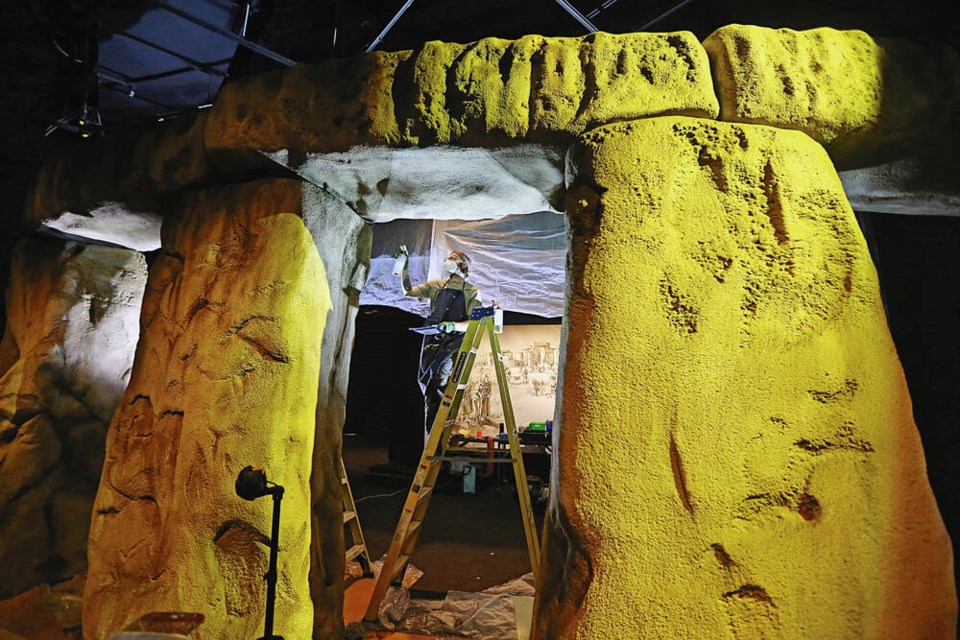Exhibit fabricator Devin Hobbins and the rest of the talented team at the Royal B.C. Museum have re-created some of the massive sarsen stones that make Stonehenge, that puzzling prehistoric circular monument in England dating back nearly 5,000 years.
But these are much lighter pillars, made with a plywood frame, coated with foam, shaped and painted, and adorned with lichens.
The real thing, it seems, until you knock it with your knuckle.
The entry to the Royal B.C. Museum’s latest blockbuster exhibit, Stonehenge, which opens today and runs through to Jan. 5, is a fitting introduction to the more than 400 artifacts on display from the UNESCO World Heritage Site.
The travelling exhibit from England is coming from a stint in Auckland, New Zealand, and has been through Belgium and three American cities.
But Victoria is getting a bonus with the burial belongings of the Stonehenge and Amesbury archers, both of which have never been seen before in North America. Those exhibits contain perfectly preserved potteries, arrowheads, tools — even gold hair clips — and other personal belongings from the ancient humans who lived, feasted and buried their dead on the site.
The exhibits contain no human remains, but the tools and methods that helped shape Stonehenge and the belongings of the thousands of people who made their homes there over the centuries provide a glimpse of the area’s fascinating history.
So who were these people who built Stonehenge and why did they push, pull and drag these massive stones from many kilometres around England to create this site?
Michael Parker Pearson, professor at the Institute of Archaeology University College London and leader of the Stonehenge Riverside Project, said science is revealing more about Stonehenge every day.
Parker Pearson, who is scheduled to give a talk on Stonehenge tonight at the museum, said isotope studies of bones and ancient DNA analysis are shedding light on the ancestral origins of Stonehenge people.
It has been commonly believed that the monuments were put up by Druids around 460 BC, but science from cremated remains tells researchers like Parker Pearson that Stonehenge was created around 3000 BC, much earlier than originally believed, and evolved over time.
He said it’s now believed that Stonehenge was built during a time of social change and involved all the people of Britain during a time when various tribes were unifying.
“There were three main population groups at Stonehenge, one after the other, starting off with hunter-gatherers who have very dark skin with blue eyes, and they were almost completely replaced in Britain by farmers who are coming in with ancestry in the Middle East,” said Parker Pearson. “Then the Beaker people came in later stages, and their origins are in what is now Ukraine and Western Russia north of the Black Sea.”
Parker Pearson said Stonehenge was not a monument for local people. It was built over the centuries and attracted people and resources from all over Britain, some coming from hundreds of kilometres away to build it and take part in festivals.
The stones were positioned — close enough but not precisely because of their sheer weight and size — to align with the sun on the solstices, creating a calendar, said Parker Pearson.
On the summer solstice, the sun rises behind the Heel Stone in the northeast part of the horizon and its first rays shine into the heart of Stonehenge. On the winter solstice, the sun sets to the southwest of the stone circle.
“It’s monumentalizing these particular moments of the eternal passage of the sun and to some extent the moon,” said Parker Pearson. “When they built the first stage, it’s a burial ground and important connection to the dead. Realizing the ancestors is important.”
The deep mystery lies in the origins of the stones, he said.
“None of the stones are local. It’s the only circle ever built entirely out of stones that have come from a distance and that is the secret to understanding it,” said Parker Pearson.
“It’s about unity. It’s about bringing different parts of Britain into one place.”
Some of the smaller blue stones of the inner circle are from Wales, 240 kilometres away, while other larger stones are from northern England and the southern coast.
“It’s becoming clear now that understanding Stonehenge is in the stones themselves. They represent ancestral emblems of belonging,” said Parker Pearson. “Every year, every month, new results are coming out with new lines of evidence, new discoveries.
“The stones from Wales … we have to look at why those stones are joining Stonehenge and what was going on in society there.”
Parker Pearson said it took hundreds of people to move the stones great distances, indicating a well-organized society.
“If you try to do [log] rollers, these stones are so heavy the rollers would become embedded in turf. They jam,” he said.
The builders likely used a wooden railway, laying timbers in the direction of movement, and putting stones on massive sledges with up to 400 people pulling and pushing.
So why that particular spot, on the Salisbury Plain?
“Even 700 years before Stonehenge, people were gathering because we found a large pit full of feasting debris,” said Parker Pearson. “This was already a landscape of people coming together at a burial grounds — the largest in Britain — and a special place for ancestral dead.
“Stonehenge is aligned on the solstice at a position on a natural land form … and they chose this place linking the heavens and the Earth, which they regarded as a supernatural significance.”
>>> To comment on this article, write a letter to the editor: [email protected]



